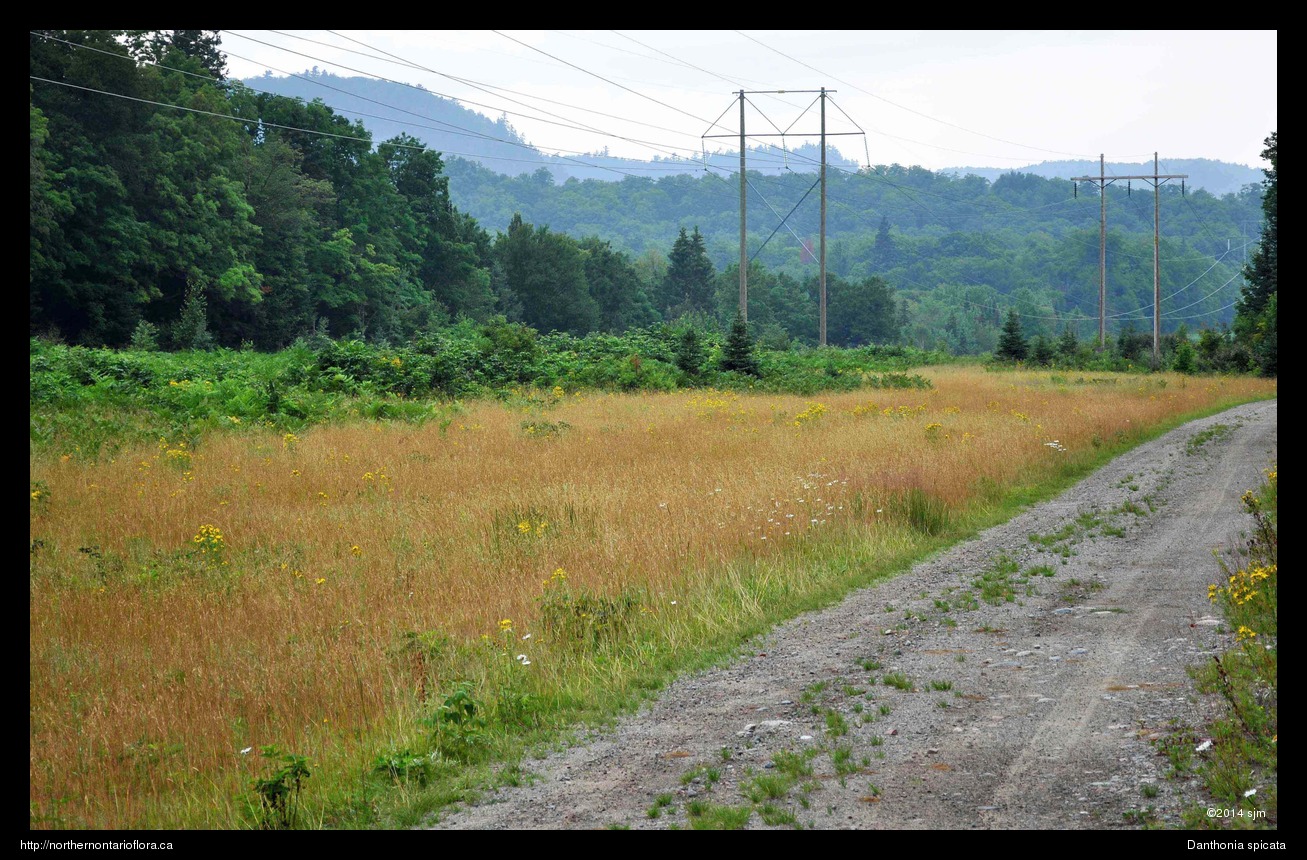
|
Northern Ontario Plant Database 
Plant DescriptionDanthonia spicata (L.) P.Beauv. ex Roem. & Schult.En: poverty oatgrass, poverty danthonia
Poaceae (Grass Family) General: A low tufting grass with a fibrous root system, spreading gradually by short lateral tillers to form dense cespitose clumps of basal leaves to 10—15 cm tall; fruiting stems (culms) are 10—60 cm in height. Poverty oatgrass is an excellent grass for stabilizing dry sandy soils, often forming extensive colonies in rights-of-way, and is able to withstand more than moderate trampling. Leaves: Basal, simple, and parallel-veined; growing in dense cespitose clumps. Leaves are flat, linear to narrowly lanceolate, 6—15 cm long by 0.8—3 mm wide, generally smooth (glabrous) on both surfaces, but sometimes hairy on the outer surface, and often curl irregularly at maturity. Leaves of the flowering and fruiting culms are few, sheathing at the base and usually hairy on the outer surface, with short ascending to erect blades that may also be hairy. The sheath is open to the base and the ligule is composed of a row of stiff hairs at the base of the blade. Above each joint (node) of the stem, a ring of spreading white hairs encircles the stem. Leaves of poverty oatgrass tufts become foxy brown in autumn. Flowers: Grass flowers are small and highly modified. In place of petals and sepals, grasses have two modified bracts, the lemma and palea, which surround the 3 stamens and single pistil of each tiny flower, called a floret. Florets are arranged in small spike-like clusters called spikelets, each of which is subtended by 2 more bracts, called glumes. The arrangement of spikelets varies greatly throughout the grass family, ranging from narrow spikes to many-branched panicles. In poverty oatgrass, each stiff flowering stem (culm) bears about 5—10 stalked spikelets near the top of the culm. During flowering, the spikelets are arranged perpendicular to the culm in an open panicle, but in fruit the slender branches bend upward, forming a narrow erect panicle of slightly overlapping spikelets. Each spikelet is 7—14 mm long and contains about 7 florets. The florets are usually closed and self-pollinating (cleistogamous), although a few plants in each population may open and fertilize through cross-pollination. In each floret, the outer of the two floret bracts, the lemma, is 2—5.5 mm long and ends in two small triangular teeth, each <2 mm long. A stiff needle-like awn, 5—8 mm long, emerges from between the two teeth of the lemma. During flowering, awns are straight and erect; in fruit, the awns twist at their purplish to bronze-coloured base, making the bent awns stick out prominently from each floret. The two glumes of each spikelet are narrowly lanceolate, nearly equal in length, and are slightly longer than the florets. Fruit: The ovary of each floret develops into an ovoid grain (caryopsis), 1.5—2 mm long and about half as wide. Grass seeds are fused to the inside wall of each grain, so the fruit and seed cannot be separated. Grains are enclosed by the awned lemma and can be easily harvested by gently pulling on the awn until the grain separates from the spikelet. Spikelets separate (disarticulate) above the glumes. In Algoma, poverty oatgrass grains mature during the latter half of August to early September. Habitat and Range: Dry sandy, rocky, or mineral soils, preferring open areas such as sunny rights-of-way or dry open woodlands; most commonly found on dry sandy soil. Plants grown in the shade tend to be taller and have fewer flowers and slightly hairy leaves, which do not curl like those of plants grown in sunny locations. Poverty oatgrass is found throughout the Algoma District and Ontario. Its range extends through temperate and boreal regions of North America, extending from Newfoundland and Labrador west to British Columbia, and from the southern Yukon south to northeastern Mexico. Poverty oatgrass is more common in eastern North America than western. Similar Species: Poverty oatgrass is most similar in form and size to wavy hairgrass (Avenella flexuosa (L.) Drejer, previously known as Deschampsia flexuosa) (L.) Trin., which has longer inrolled leaves (12—25 cm long) and slightly taller culms (30—80 cm tall). The flowering heads of wavy hairgrass are more branched and open than those of poverty oatgrass, each spikelet contains only two florets, and a bent awn is attached near the base of each lemma. Back to species list |
||||||||||||||||||||||






















